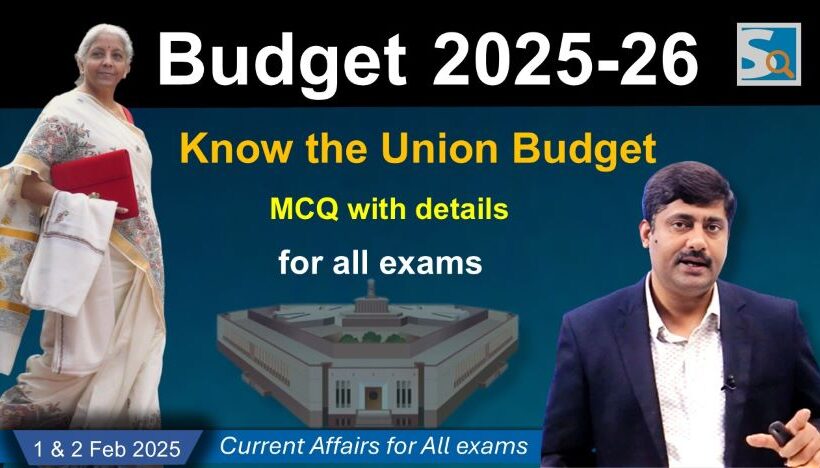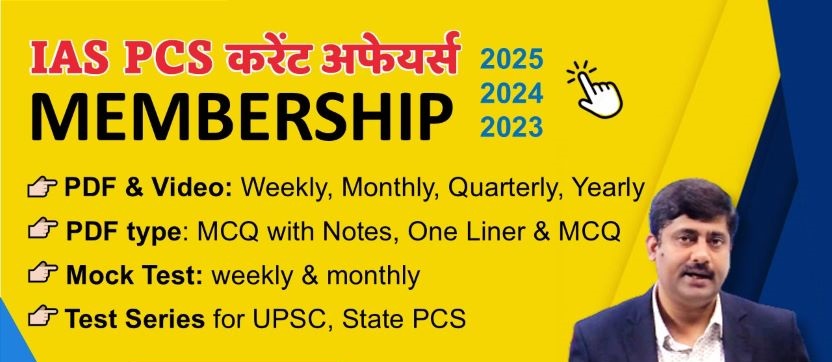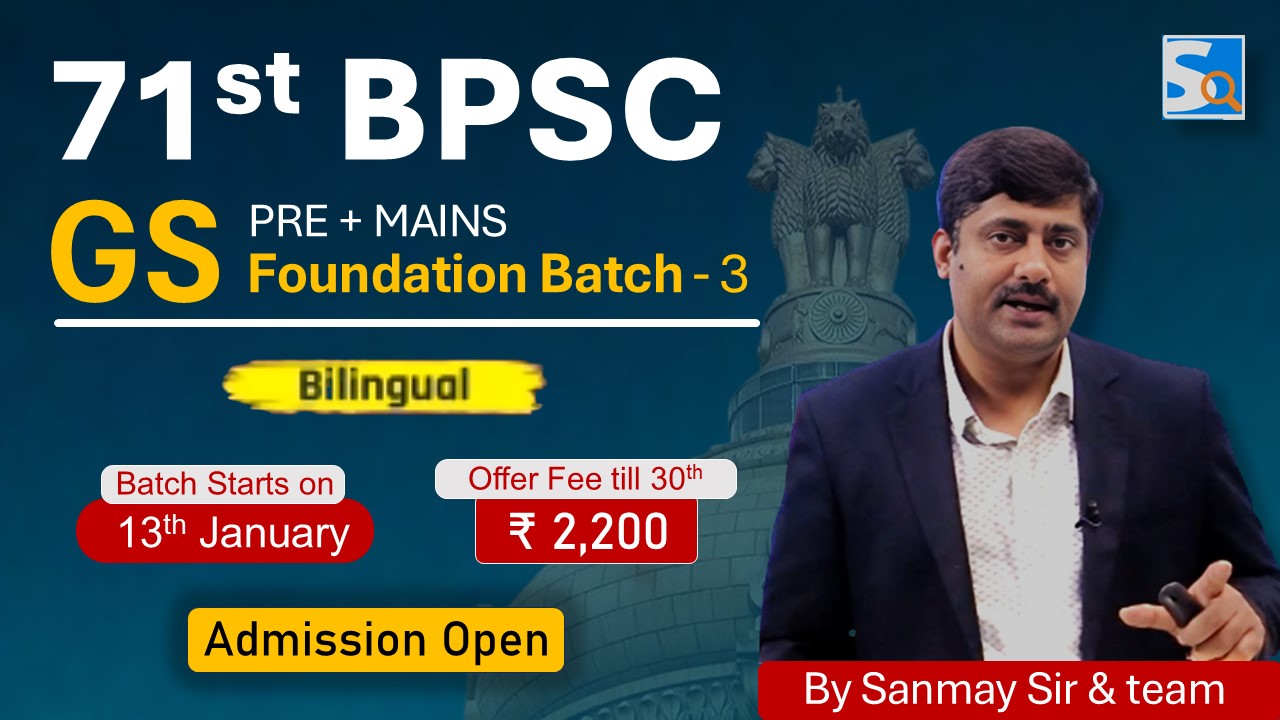This is the current affairs of 1st & 2nd February 2025 related to Union Budget 2025-26. Daily current affairs questions and answers are given here for better preparation of competitive examination for government jobs.
PDF Download: Click here
1. In the Union Budget 2025-26, the Central Government has set a target of how much income and expenditure?
a. 39.44 lakh crore
b. 42.50 lakh crore
c. 48.21 lakh crore
d. 50.65 lakh crore
Answer: d. 50.65 lakh crore
– Finance Minister Nirmala Sitharaman presented the Union Budget for the financial year 2025-26 in Parliament.
– Nirmala Sitharaman presented the budget for the 8th consecutive time.
– Last time, the budget was presented in July 2024. Before that, an interim budget was presented in February 2024.
– This was the country’s sixth paperless (digital) budget.
Income Target in the Budget: ₹50.65 Lakh Crore
– Revenue Receipts: ₹34.20 Lakh Crore
– Capital Receipts: ₹16.44 Lakh Crore
Note: In the previous financial year (2024-25), the estimated income in the budget was set at ₹48.20 Lakh Crore. However, the revised estimate stood at ₹47.16 Lakh Crore.
—–
Revenue Receipts – Income received by the government through taxes.
Capital Receipts – Funds received through loans or income generated from assets owned by the government. These are not taxed.
Sources of Income
# 24% – Borrowing & Other Liabilities (Loans and Other Obligations) [₹16.13 Lakh Crore]
# 22% – Income Tax
# 18% – GST
# 17% – Corporation Tax
# 9% – Non-Tax Revenue (Non-Debt Capital Receipts)
# 5% – Union Excise Duty
# 4% – Customs (Import Duty)
# 1% – Non-Debt Capital Receipts
# Expenditure Target in the Budget: ₹50.65 Lakh Crore
– Revenue Expenditure: ₹39.44 Lakh Crore (Including ₹12.76 Lakh Crore for Interest Payments)
– Capital Expenditure: ₹11.21 Lakh Crore
Note: In the previous financial year (2024-25), the estimated expenditure in the budget was set at ₹45.03 Lakh Crore. However, the revised estimated expenditure stood at ₹44.90 Lakh Crore.
—–
Revenue Expenditure – Expenses related to salaries, infrastructure maintenance, etc.
Capital Expenditure – Funds spent on infrastructure development, such as building roads, bridges, and purchasing fighter jets.
Sources of Expenditure
# 22% – Share of Taxes & Duties to States
# 20% – Interest Payment (Loan Repayment) [₹11.62 Lakh Crore]
# 16% – Central Sector Schemes
# 8% – Finance Commission & Other Transfers
# 8% – Centrally Sponsored Schemes
# 8% – Defense
# 6% – Subsidies
# 4% – Pension
# 8% – Other Expenditures
Transfers to States & Union Territories
– The budget allocated approximately ₹25.6 Lakh Crore for transfers to states and Union Territories.
– Out of this, ₹14.2 Lakh Crore came from the transfer of states’ share in taxes.
– Another ₹1.32 Lakh Crore came from Finance Commission grants.
– The remaining ₹10.05 Lakh Crore was allocated for scheme-related and other transfers.
—————
2. In the Union Budget 2025-26, the Finance Minister has set the fiscal deficit target at what percentage of GDP?
a. 5.1%
b. 4.4%
c. 4.9%
d. 3.8%
Answer: b. 4.4% (Figure in rupees 15.68 lakh crore)
– According to the National Statistical Office (NSO), the total GDP estimate for 2025-26 is ₹356.97 Lakh Crore.
– In the previous financial year (2024-25), the estimated fiscal deficit stood at 4.8%.
– The government covers this deficit by borrowing or taking loans.
What is Fiscal Deficit?
Fiscal Deficit = Total Non-Debt Expenditure – Total Non-Debt Receipts
– Total Non-Debt Expenditure means total expenditure without considering loans.
– Total Non-Debt Receipts means revenue receipts and capital receipts without loans.
– The fiscal deficit is the amount left after subtracting revenue receipts, loan recoveries, and loan repayments (Total Non-Debt Receipts) from total expenditure.
– (To put it simply, it’s the difference between income and expenditure. It means the income was less, but the expenditure was more, and to cover it, the government had to take loans.)
—-
– Fiscal discipline has been maintained, and the deficit has been reduced despite a decrease in revenue.
– When governments spend more or provide tax exemptions, there is a fear that they will be forced to borrow more money.
– When governments borrow more, they either leave less money for private citizens and companies to borrow, which in turn increases interest rates for everyone, or they are forced to print more money – leading to inflation, which acts like a tax as it reduces the purchasing power of people’s money.
– However, despite large-scale tax cuts, which will result in a revenue loss of nearly ₹1 Lakh Crore for the government, the fiscal deficit (or the level of borrowed funds) will further decrease to 4.4% of GDP in 2025-26, the Finance Minister stated.
—-
—————-
3. How much amount (with pension) has been allocated to the Ministry of Defence in the Union Budget 2025-26?
a. Rs 5.2 lakh crore
b. Rs 6.8 lakh crore
c. Rs 6.81 lakh crore
d. Rs 6.21 lakh crore
Answer: c. Rs 6.81 lakh crore (5.20 lakh crore without pension)
– This time, the Ministry of Defence has received a total amount of ₹6.81 Lakh Crore.
– This includes ₹1.60 Lakh Crore for pensions.
– The total defense budget has seen an increase of 9.53% compared to last time.
– In the previous financial year’s budget (2024-25), this amount was ₹6.21 Lakh Crore.
– This time, defense has received 13.45% of the total budget, the highest among all ministries. Last year, this share was about 12.9%.
– This time, the capital expenditure is ₹1.8 Lakh Crore. This amount will be spent on purchasing weapons and the modernization of the army.
Defense Budget Breakdown
– The defense budget mainly consists of three parts: Revenue, Capital Expenditure, and Pensions.
– Revenue Budget includes defense staff salaries and other expenses of the armed forces, such as infrastructure maintenance, road construction, and bridge building.
– Capital Expenditure is used for purchasing weapons, ammunition, fighter planes, etc. This part is the most crucial for the army’s strength.
– The Finance Minister has allotted ₹1.8 Lakh Crore for the capital budget, which is 26.43% of the total defense budget.
– This will provide enough financial space to purchase advanced light helicopters, Dornier aircraft, fast patrol vessels, training ships, and interceptor boats.
– The Border Roads Organisation (BRO) has received ₹7,146 Crore under the capital budget, meaning there will be a larger-scale construction of roads, bridges, and tunnels along the border.
Note: Before March 31, 2025, two major defense deals are expected to be finalized with France: 26 Rafale-M fighter jets for carrier operations and three more Scorpène-class conventional submarines, with a total cost exceeding $10 billion. These deals are likely to be concluded around Prime Minister Narendra Modi’s visit to Paris on February 10-11.
————-
4. How much budget has been allocated to important ministries under the interim budget 2025-26?
– Ministry of Finance: ₹19.39 Lakh Crore
– Ministry of Defence: ₹6.81 Lakh Crore (₹5.20 Lakh Crore excluding pensions)
– Ministry of Road Transport and Highways: ₹2.87 Lakh Crore
– Ministry of Railways: ₹2.55 Lakh Crore
– Ministry of Home Affairs: ₹2.33 Lakh Crore
– Ministry of Consumer Affairs, Food & Public Distribution: ₹2.15 Lakh Crore
– Ministry of Rural Development: ₹1.90 Lakh Crore
– Ministry of Chemicals and Fertilizers: ₹1.61 Lakh Crore
– Ministry of Communications: ₹1.08 Lakh Crore
– Ministry of Agriculture and Farmers’ Welfare: ₹1.37 Lakh Crore
– Ministry of Education: ₹1.28 Lakh Crore
– Ministry of Health & Family Welfare: ₹99.85 Thousand Crore
– Ministry of Housing & Urban Affairs: ₹96.77 Thousand Crore
– Ministry of Women & Child Development: ₹26 Thousand Crore
– Ministry of Youth Affairs & Sports: ₹3.74 Thousand Crore
Ministry of Jal Shakti (Water Resources): ₹99 Thousand Crore
– Department of Atomic Energy: ₹24 Thousand Crore
– Ministry of AYUSH: ₹3.99 Thousand Crore
Note: If we look at sector-wise expenditure, these are the figures. Keep in mind that some ministries’ work may have been added or subtracted, so the numbers may differ from individual ministries:
– Interest: ₹12.76 Lakh Crore
– Transport (all kinds): ₹5.48 Lakh Crore
– Defense: ₹4.91 Lakh Crore
– All types of pensions: ₹2.76 Lakh Crore
– Rural Development: ₹2.66 Lakh Crore
– Agriculture & related activities: ₹1.71 Lakh Crore
– Home Affairs: ₹2.33 Lakh Crore
– Education: ₹1.28 Lakh Crore
– IT & Telecom: ₹1.16 Lakh Crore
– Health: ₹98 Thousand Crore
– Energy: ₹81 Thousand Crore
– Social Welfare: ₹60 Thousand Crore
– Commerce & Industry: ₹65 Thousand Crore
————–
5. According to Finance Minister Nirmala Sitharaman, what is the main theme of the Union Budget 2025-26?
a. Employment for all, skill training
b. MSME
c. Middle class
d. Development for all
Answer: d. Development for all
– While presenting the budget, Nirmala Sitharaman referred to the famous quote by Telugu poet and playwright Sri Gurajada Appa Rao, “A country is not only made of its soil, but it is made by its people.”
– She mentioned that the budget is designed with the goal of “inclusive development,” aiming for balanced development across all sectors.
Finance Minister Mentioned the Broad Principles for a Developed India
1. Freedom from poverty
2. 100% quality schooling for all
3. Excellent, affordable, and accessible healthcare services
4. Meaningful employment with 100% skilled workforce
5. 70% women involved in economic activities
6. Farmers who will make our country the ‘Food Basket of the World’
Engines of India’s Journey Toward Development
– First Engine: Agriculture
– Second Engine: MSMEs (Micro, Small, and Medium Enterprises)
– Third Engine: Investment
– Fourth Engine: Exports
————–
6. During the Union Budget 2025-26 speech, the Finance Minister announced income tax exemption up to how much amount in the new income tax regime?
a. Rs 10 lakh
b. Rs 12 lakh
c. Rs 14 lakh
d. Rs 16 lakh
Answer: b. Rs 12 lakh
Two Types of Income Tax Regimes in the Country
– New Tax Regime
– Old Tax Regime
New Tax Regime
– Income up to ₹4 Lakh: 0%
– Income between ₹4-8 Lakh: 5%
– Income between ₹8-12 Lakh: 10%
– Income between ₹12-16 Lakh: 15%
– Income between ₹16-20 Lakh: 20%
– Income between ₹20-24 Lakh: 25%
– Income above ₹24 Lakh: 30%
Note: In the new tax regime, the government will directly waive the 5% tax on income between ₹4-8 Lakh and the 10% tax on income between ₹8-12 Lakh.
No Tax on Income up to ₹12 Lakh, But How?
– There will be no tax on income up to ₹12 Lakh.
– Salaried individuals will also receive an additional standard deduction of ₹75,000, meaning income up to ₹12.75 Lakh will be tax-free. However, two conditions apply:
– This change applies only to the new tax regime. Those who have chosen the old tax regime will not benefit from this.
– This benefit will specifically apply to those whose income is from salary. If you have earned capital gains (e.g., by investing in the stock market, mutual funds, or buying and selling property, which is subject to tax), this arrangement will not apply.
Old Tax Regime
– Income up to ₹3 Lakh: 0%
– Income between ₹3-7 Lakh: 5%
– Income between ₹7-10 Lakh: 15%
– Income between ₹10-15 Lakh: 20%
– Income above ₹15 Lakh: 30%
Special Features of the Old Tax Regime
In the old tax regime, you can avail tax deductions for:
– Investments
– Health insurance
– Children’s school fees
– Rent paid for accommodation
————–
7. In which state was the formation of Makhana Board announced in the Union Budget 2025-26?
a. West Bengal
b. Odisha
c. Bihar
d. Gujarat
Answer: c. Bihar
– A Key Point: Bihar’s Name Came Up Repeatedly in the Entire Budget Speech.
Makhana Board
– Bihar’s Makhana has also received a GI tag.
– Makhana is cultivated in 10 districts of Bihar.
– These districts include Sitamarhi, Madhubani, Darbhanga, Supaul, Saharsa, Madhepura, Araria, Purnia, Katihar, and Kishanganj.
– Over 30,000 farmers are involved in Makhana cultivation.
– Due to the lack of a clear policy for Makhana, profits get divided.
– Instead of benefiting the farmers, the profits end up in the pockets of businesspeople.
– Now, with the formation of the board, more profits will stay in Bihar.
– The formation of the board will centralize all the schemes. For example, the Bihar government is running the Makhana Development Scheme. In addition, there are separate schemes from the Central Government’s MSME and Food Processing Ministry. All these schemes will be centralized.
Makhana Trade in India
– 80-90% of the world’s Makhana is grown in India.
– 90% of India’s Makhana is grown in Bihar.
– Districts like Sitamarhi, Madhubani, Darbhanga, Supaul, Saharsa, Madhepura, Araria, Purnia, Katihar, and Kishanganj are famous for Makhana cultivation.
– India exports 100 tons of Makhana every year.
– India exports Makhana primarily to the USA, UK, and Canada.
– India produces 50-60 thousand tons of Makhana seeds every year.
Nutritional Benefits of Makhana
– 100 grams of Makhana contains 350 kcal of energy.
– It is rich in carbohydrates, protein, fiber, calcium, potassium, and phosphorus.
– It contains very little fat.
Makhana Cultivation
– There is only one research center for Makhana cultivation in India, located in Darbhanga, Bihar.
– Makhana is grown in areas with stagnant water.
– However, the soil should not be sandy.
– The presence of mud is necessary in waterlogged areas.
– The depth should be 3-4 feet.
– The water’s pH (acidity) level should be neutral for better Makhana cultivation.
– The pH level should be between 6.5 and 7.5.
Makhana can also be grown in fields.
– If the embankment of paddy fields is raised to 2-2.5 feet and filled with 1.5 feet of water, Makhana can be cultivated in fields.
Where is the Yield Better?
– In ponds, the yield is 20-25 quintals per hectare.
– In fields, the yield is 30-35 quintals.
————-
8. What did the Finance Minister announce for Bihar during the Budget Speech 2025-26?
a. Makhana Board, National Institute of Food Technology
b. Expansion of IIT Patna
c. 3 airports (two expansion and one new), Western Kosi Canal Project
d. All of the above
Answer: d. All of the above (Makhana Board, National Institute of Food Technology, Expansion of IIT Patna, 3 airports {two expansion and one new}, Western Koshi Canal Project)
5 Announcements for Bihar:
– Makhana Board
– National Institute of Food Technology
– Expansion of IIT Patna
– 3 Airports (Expansion of Patna and Bihta Airports, and construction of a new greenfield airport, location not decided)
– Western Kosi Canal Project
Western Kosi Canal Project
– This project has three main objectives:
1. Power generation
2. Improving irrigation facilities
3. Flood control
– The government will provide financial assistance for the Western Kosi Canal Project. However, the exact amount and timeline for this assistance have not been disclosed yet.
Expansion of IIT Patna
– Bihar has about 50% of its population as youth. The only IIT in the state is IIT Patna. Currently, it has 2,883 seats, which will increase to around 5,000.
6 Months Ago, Bihar Was Allocated a ₹59,000 Crore Budget
– In the budget presented on July 23, 2024, Finance Minister Nirmala Sitharaman announced ₹59,000 crore worth of plans for Bihar.
– These included 3 expressways, a power plant, ₹11,500 crore for flood protection, a two-lane bridge over the Ganga river in Buxar, and plans to develop Gaya, Bodh Gaya, and Nalanda as tourist destinations. These projects are still on paper at the moment.
————–
9. To which of the following has the highest amount been allocated by the Finance Minister in the Union Budget 2025-26?
a. Urea Subsidy
b. National Highway Authority
c. PM Garib Kalyan
d. MNREGA
Answer: c. PM Garib Kalyan (2.03 lakh crore)
Budget 2025-26 Allocation for Top 10 Schemes (Excluding Education and Health)
1. PM Garib Kalyan Yojana: ₹2.03 lakh crore
2. National Highway Authority: ₹1.70 lakh crore
3. Urea Subsidy: ₹1.19 lakh crore
4. Road Construction: ₹1.60 lakh crore
5. MGNREGA: ₹86,000 crore
6. Jal Jeevan Mission: ₹67,000 crore
7. Kisan Samman Nidhi: ₹63,500 crore
8. Pradhan Mantri Awas Yojana (PMAY-G): ₹54,800 crore
9. Aircraft and Euro Engine: ₹48,600 crore
10. Rolling Stock (Railways): ₹45,500 crore
————–
10. New Announcements and Allocations in Budget 2025-26
For Women: Term Loan Up to ₹2 Crore:
– 5 lakh SC-ST women who are first-time entrepreneurs will be provided a term loan of up to ₹2 crore over the next 5 years.
– More than 8 crore children and 1 crore pregnant women across the country will receive nutritious food under the Anganwadi Scheme.
– Mission Shakti Scheme: A budget of ₹3,150 crore has been allocated for this scheme. Of this, ₹629 crore will be allocated to initiatives such as Beti Bachao-Beti Padhao, Nari Adalat, Women Helpline, and Women Police Volunteers.
For Youth and Employment:
– Startup Fund: A fund of ₹10,000 crore will be established for startups.
– AI Excellence Centers: 3 AI Excellence Centers will be created with ₹500 crore.
– Medical Education: Over the next 5 years, 75,000 new medical seats will be added, with 10,000 seats being increased annually.
– IIT Expansion: 6,500 seats will be added across 23 IITs in India, and the IIT Patna hostel will be expanded.
– PM Research Fellowship: 10,000 new fellowships will be provided under the PM Research Fellowship program.
– Employment Creation: Although no specific employment announcements were made, Finance Minister Nirmala Sitharaman stated that the new schemes would lead to job creation.
For Farmers:
– PM Dhan-Dhanayojana in 100 Low Productivity Districts:
The scheme will be implemented in 100 districts with low productivity to enhance production. Storage arrangements will be made at the panchayat level, benefiting 1.7 crore farmers.
– The KCC limit will be increased from ₹3 lakh to ₹5 lakh.
Loans for Dairy and Fisheries:
– Loans of up to ₹5 lakh will be provided for dairy and fish farming.
– A 6-year mission will be launched to achieve self-reliance in pulses, under which Nafed and other central agencies will purchase pulses from farmers for the next 4 years.
– A 5-year plan for cotton production will be implemented, focusing on production and marketing. A new urea plant will be established in Assam’s Namrup.
—
For Education:
– The Gyaan Bharat Mission will be launched in the country, aiming for the digitization of 1 crore manuscripts.
– All government secondary schools and primary health centers will be provided with broadband connectivity.
– To enhance skills, 5 national-level centers will be established.
For Health:
– The government has made 36 life-saving medicines completely tax-free.
– To provide relief to people and families fighting cancer, 200 daycare cancer centers will be established in district hospitals across the country within the next 3 years.
For Online Delivery & Cab Drivers:
– 1 crore GIG Workers (food delivery drivers, cab drivers, and online delivery workers) will be provided with ID cards.
– They will be registered on the e-Shram portal and will be eligible for health benefits under the Pradhan Mantri Jan Aarogya Yojana.
– According to reports, by 2030, the number of GIG workers is expected to exceed 23 crore.
Turning the Country into a Toy Hub:
– A National Action Plan will be created to turn the country into a major center for toys. Clusters will be developed, and an ecosystem for skill development and manufacturing will be established. This will lead to the creation of high-quality, unique, innovative, and durable toys.
– Due to an overall global decline in demand for these products, India’s toy exports fell from USD 177 million in 2021-22 to USD 152 million in 2023-24.
– Over the past decade, India has increasingly relied on China for toys. Currently, the country imports an average of 76% of its toys.
For Tribals: DAJGUA Budget Quadrupled:
– The budget for the Dhartī Abha Janjati Grama Utkarsh Abhiyan (DAJGUA) has been increased fourfold from ₹500 crore to ₹2,000 crore.
– This will improve health facilities, education, and anganwadi services in 63,843 villages, benefiting 5 crore tribal people across 549 districts in 30 states.
– More than ₹7,000 crore has been allocated for Eklavya Boarding Schools, and ₹380 crore will be allocated for the Tribal Development Mission.
– The Pradhan Mantri Adi Adarsh Gram Yojana will receive a budget of more than ₹335 crore.
100% FDI Allowed in Insurance Sector:
– Previously, the insurance sector allowed only 74% foreign direct investment (FDI). This has now been increased to 100%.
————-
11. Finance Minister Nirmala Sitharaman presented the budget for what th time on 1 February 2025?
a. 5th time
b. 8th time
c. 9th time
d. 10th time
Answer: b. 8th time
————-
12. In the budget 2025-26, there is a provision for giving maximum grant-in-aid to which neighboring country?
a. Afghanistan
b. Bhutan
c. Sri Lanka
d. Maldives
Answer: b. Bhutan (Rs 2150 crore grant)
– The budget includes a provision of a total of ₹2150 crore as grants for Bhutan, of which ₹375 crore will be in the form of loans.
– India provides economic aid to more than a dozen countries.
Aid and Grant Amounts for Various Countries:
1. Bhutan: ₹2150 crore (including ₹375 crore as loan)
2. Afghanistan: ₹100 crore
3. Bangladesh: ₹120 crore
4. Nepal: ₹700 crore
5. Sri Lanka: ₹300 crore
6. Maldives: ₹600 crore
7. Myanmar: ₹350 crore
8. Mongolia: ₹5 crore
9. African countries: ₹225 crore
10. Eurasian countries: ₹40 crore
11. Latin American countries: ₹60 crore
12. Other developing countries: ₹150 crore
13. Disaster relief: ₹64 crore
14. Chabahar Port: ₹100 crore
15. Mauritius: ₹500 crore
16. Seychelles: ₹19 crore




